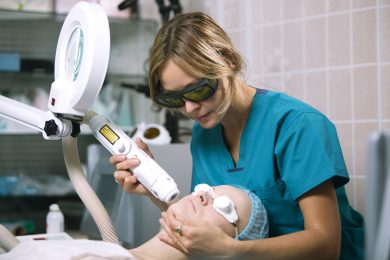Laser hair removal & Hirsutism
Excessive or heightened hair growth in women characterizes the condition known as Hirsutism. This disorder is prevalent, and its manifestation can vary based on an individual’s racial or ethnic background.
Causes of Hirsutism
In many instances, the root cause of excessive hair growth is the overproduction of the male hormone “androgen” within the female body. It’s important to note that all women naturally have a certain level of this hormone—the same as all men have estrogen in their bodies. However, when androgen hormones are produced in excess, it can result in unwanted and excessive hair growth.
Nevertheless, androgen hormones are not the sole culprits behind excessive hair growth. Other contributing factors may include genetic predisposition, Polycystic Ovary Syndrome, and thyroid gland disorders.
What areas are primarily affected by hair growth in women with Hirsutism?
Hirsutism in women primarily affects hair growth in the following areas:
- Face: Excessive hair growth on the upper lip, chin, and cheeks can be a common manifestation of Hirsutism.
- Chest: Some women with Hirsutism may experience increased hair growth on the chest.
- Back: Hair growth on the lower back can also concern women with Hirsutism.
- Abdomen: Hair may grow in excess on the stomach, particularly in the lower abdominal area.
- Thighs: Sometimes, Hirsutism can increase hair growth on the inner and outer thighs.
Treatment for Hirsutism
As with any medical condition, the appropriate treatment for Hirsutism largely depends on the diagnosis. A case arising from a thyroid condition would necessitate a different approach than one caused by a hormonal imbalance. However, many individuals discover that identifying the underlying cause enables the prescribed treatment to produce the desired results.
Because excessive hair growth can draw attention and create social discomfort, many women look for treatments that can tackle the issue and provide ways to hide or control it temporarily. Consequently, numerous patients explore medical treatments and cosmetic solutions like laser hair removal.
For individuals grappling with a hormonal imbalance, addressing the root issue can enhance the effectiveness of laser hair removal. Laser treatments deliver superior results to alternative methods, even for those with an imbalance.
In the past, it was a well-known misconception that hair removal could cause the overgrowth of thicker hair. That deterred many women from seeking hair removal treatments. We now understand this as a fallacy, as no scientific evidence suggests that any hair removal method promotes increased hair growth.
Solution – Laser hair removal
Laser hair removal is an effective solution because it offers longer-lasting results than shaving or plucking and can permanently reduce hair growth.
Typically, laser hair removal sessions are spaced four to six weeks apart. During this time, individuals would need to remove hair just a few times to maintain the appearance of hair not being visible.





